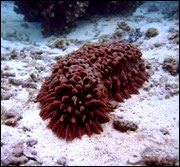Whether you accept it, avoid it or live somewhere in between, insurance coverage has become a defining issue for our profession. Patients increasingly expect to use their benefits, practitioners want to be compensated fairly for their time and expertise, and the system itself remains – at best – fragmented. The encouraging news is that coverage has expanded in meaningful ways. The challenging news is that reimbursement, across the board, remains inadequate.
Herbs & Botanicals
Sea Cucumber (hai shen)
What is sea cucumber? What is it used for?
Sea cucumber is not a plant, but actually an animal similar to a slug. It is a sea creature, resembling a cucumber in appearance, which is related to sea urchins and starfish, and resides on the ocean floor.
There are hundreds of varieties of sea cucumber found throughout the world. It is considered a delicacy in some cultures, and is a staple of some forms of Chinese cuisine. In addition to its uses as a food, however, sea cucumber is also prized for its medicinal properties. In traditional Chinese medicine, sea cucumber has salty and warm properties, and is associated with the Heart and Kidney meridians. It is believed to help nourish the yin and blood, and is a tonic herb for treating the kidneys. It is used to treat a variety of conditions, including impotence and frequent urination. Studies conducted in China have found that sea cucumber is a good source of chondroitin. As a result, many practitioners recommend sea cucumber to help treat arthritis, tendonitis and joint pain. It is also an extremely good source of protein.
In traditional Chinese medicine, sea cucumber has salty and warm properties, and is associated with the Heart and Kidney meridians. It is believed to help nourish the yin and blood, and is a tonic herb for treating the kidneys. It is used to treat a variety of conditions, including impotence and frequent urination. Studies conducted in China have found that sea cucumber is a good source of chondroitin. As a result, many practitioners recommend sea cucumber to help treat arthritis, tendonitis and joint pain. It is also an extremely good source of protein.
How much sea cucumber should I take?
To help treat arthritis, most practitioners recommend 600-1,200 milligrams of powdered sea cucumber, taken once per day with water during a meal. Other doses may be used to treat different conditions.
What forms of sea cucumber are available?
Fresh sea cucumber can be found at some Asian markets. If being used as food, the sea cucumber often needs to be rehydrated, which can take several hours. Powdered sea cucumber can also be found at some specialty stores and herbal shops, along with sea cucumber pills and capsules.
What can happen if I take too much sea cucumber? Are there any interactions I should be aware of? What precautions should I take?
As of this writing, there are no known drug interactions or adverse side-effects associated with consuming sea cucumber. If eating fresh sea cucumber, however, make sure that the animal has been cleaned and cooked thoroughly before consumption. As always, make sure to consult with a licensed health care provider before using sea cucumber or any other herbal remedy or dietary supplement.
References
- Avilov SA, Antonov AS, Silchenko AS, et al. Triterpene glycosides from the Far Eastern sea cucumber cucumaria conicospermium. J Nat Prod July 2003;66(7):910-6.
- Moraes G, Northcote PT, Silchenko AS, et al. Mollisosides A, B(1), and B(2): minor triterpene glycosides from the New Zealand and South Australian sea cucumber australostichopus mollis. J Nat Prod June 24, 2005;68(6):842-847.
- Pechenik JA. Biology of the Invertebrates. Singapore: McGraw-Hill Book Co., 2000.
- Ruhl HA, Smith KL Jr. Shifts in deep-sea community structure linked to climate and food supply. Science July 23, 2004;305(5683):513-5.
- Tan LWH, Ng PKL. A Guide to Seashore Life. Singapore: The Singapore Science Centre, 1998.


